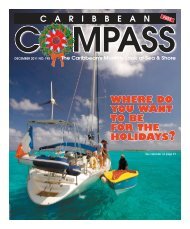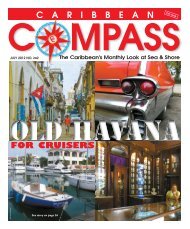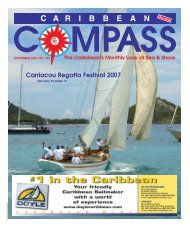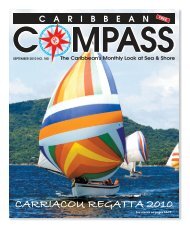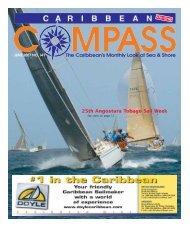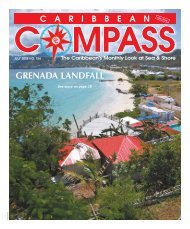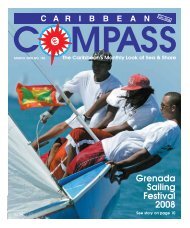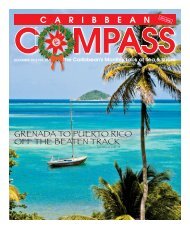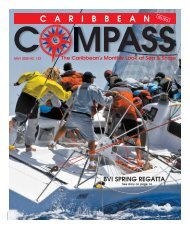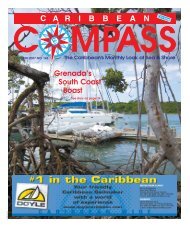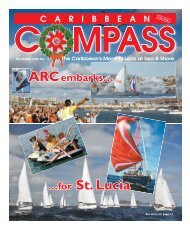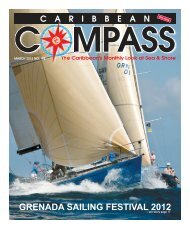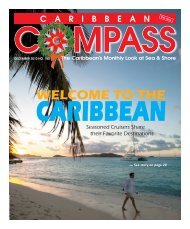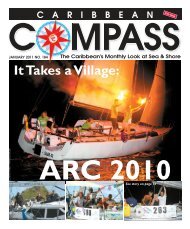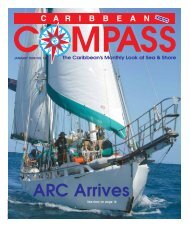Create successful ePaper yourself
Turn your PDF publications into a flip-book with our unique Google optimized e-Paper software.
MAY <strong>2009</strong> CARIBBEAN COMPASS PAGE 38<br />
Private crewed yachts<br />
wanted for charters<br />
Grenada-Grenadines<br />
Yacht must be in good conditions with at least<br />
one cabin and separate washroom for guests.<br />
Two persons crew required. Year round income.<br />
Call Daniela in Grenada (473) 443 3424<br />
or email dg@caribservice.com<br />
www.caribbean-sun.com www.karibikreisen.com<br />
Catamaran Dean 400 for sale<br />
3 large cabins, each<br />
with private bathroom,<br />
well looked after and<br />
ready to go. Built 1996.<br />
Price US$135.000.<br />
Located in Grenada.<br />
Call (473) 443-3424<br />
(ask for Bernhard) or Email dani@caribsurf.com.<br />
If interested: yearly charter income of<br />
US$30.000 - 40.000 guaranteed by seller.<br />
GOOD GUIDES ARE TIMELESS<br />
Rocks don’t move — or if they do they are shown on<br />
up-to-date Imray charts. Regarding marine<br />
infrastructure, virtually every island puts out a free<br />
marine trade guide every year, which is much more<br />
up-to-date than any guide; similarly, the tourist<br />
departments put out a free annual guide for bars,<br />
restaurants and hotels.<br />
With all these updates readily available,<br />
Street’s guides are timeless.<br />
Real sailors use Street’s Guides for inter-island and harbor<br />
piloting directions, plus interesting anecdotes of people,<br />
places and history. Street’s Guides are the only ones that<br />
describe ALL the anchorages in the Eastern <strong>Caribbean</strong>.<br />
NEW! Street’s videos, first made in 1985,<br />
are now back as DVDs.<br />
• “Transatlantic with Street” documents a sailing passage<br />
from Ireland to Antigua via the Cape Verdes. 2 hours<br />
• “Antigua Week ’85” is the story of the engineless yawl Iolaire<br />
racing round the buoys to celebrate her 80th birthday. 1 hour<br />
• “Street on Knots” demonstrates the essential knots and<br />
line-handling skills every sailor should know. 1 hour<br />
• “Streetwise 1 and 2” give tips that appeared in the popular video<br />
Sailing Quarterly, plus cruises in the Grenadines, Venezuela and<br />
southwest coast of Ireland<br />
DVDs available at Imray, Kelvin Hughes, Armchair Sailor/<br />
Bluewater Books, and www.street-iolaire.com.<br />
Full information on DVDs at www.street-iolaire.com<br />
HURRICANE TIPS! Visit www.street-iolaire.com for a wealth of<br />
information on tracking and securing for a storm.<br />
Street’s Guides and DVDs are available<br />
at all Island Waterworld stores and at Johnson's Hardware,<br />
or from www.iUniverse.com and www.seabooks.com<br />
DOLLY’S ANSWERS<br />
Ten different types of hard coral named according<br />
to what they look like are:<br />
sheet<br />
tube<br />
fungus<br />
rose<br />
brain<br />
staghorn<br />
finger<br />
flame<br />
star<br />
lettuce<br />
READERS'<br />
FORUM<br />
Dear <strong>Compass</strong> Readers,<br />
I wish to comment further on the letter submitted by<br />
Tom Hankins in the March edition.<br />
Despite having missed previous readers’ correspondence<br />
on the subject of sailing without insurance,<br />
which has obviously been a topic in past columns of<br />
this organ, I find the letter from Tom Hankins stands<br />
alone as warning to those who would consider “self<br />
insurance”, to use the polite term, as a responsible<br />
policy when cruising.<br />
Mr. Hankins postulates two scenarios as examples<br />
of the risks of sailing uninsured — both are realistic<br />
and possible, if unlikely, events. However there is a<br />
much more common and therefore greater risk to the<br />
uninsured, and in this case “fully insured”, yachtsman<br />
that he, like most of us, was probably unaware of.<br />
It has happened to me.<br />
Be aware that if another vessel drags its anchor or<br />
mooring onto your own moored/anchored yacht and<br />
you suffer damage as a result, the insurers (if insured)<br />
for the vessel that dragged onto you will avoid paying<br />
any third-party claims until you can prove negligence<br />
on the part of the owner or captain of the dragging<br />
vessel. The onus is on you.<br />
I quote legal advice given to me when incredulous<br />
that such a situation could exist:<br />
“Whilst I understand your apparent frustration I can<br />
only advise on the basis of the facts, evidence and how<br />
they relate to the law, in this case Negligence.<br />
Negligence is of course a civil wrong but it is the party<br />
wishing to show negligence (in this case you) to make<br />
your case, ultimately to a court, and not for the defendant.<br />
In consequence the burden falls on you although<br />
a good defence will also obtain evidence to counter any<br />
issues that you consider relevant to a case in negligence.<br />
In negligence we have to show that the other<br />
yacht owner owed you a duty of care and breached<br />
that duty.”<br />
To prove negligence in a court of law is incredibly<br />
expensive and difficult to do. Unless a substantial claim<br />
is on the books, even if you had additional legal cover<br />
(as in my case), more often than not your insurers or<br />
lawyers will drop or advise you to drop the case.<br />
In my case, the owner of the dragging vessel had<br />
abandoned it for the winter on a “summer mooring” in<br />
Mallorca and returned to England without appointing<br />
any local representative to handle things in his<br />
absence. This summer (lightweight) mooring dragged<br />
50 meters until it fouled my own substantial mooring<br />
blocks thus arresting its voyage to the surrounding<br />
rocks where it would inevitably have become a total<br />
loss. Despite separating the two vessels, spending half<br />
a day with two helpers and a dinghy to re-moor the<br />
offending yacht, and thereby saving its owners and<br />
insurers a massive claim, my only reward was months<br />
of correspondence, and loss of a ten-year no-claims<br />
bonus and my US$1,000 excess, apart from weeks in<br />
a shipyard and all the hassle that goes with it. Not a<br />
single word from the owner of the other boat.<br />
Insured or uninsured, be very aware of that badly<br />
moored yacht ahead of you.<br />
Chris Long<br />
Yacht Tropical Dream<br />
Dear <strong>Compass</strong> Readers,<br />
As some of you know, we on S/V Second Millennium<br />
have not been avid supporters of eSeaClear [as covered<br />
in <strong>Compass</strong> and commented on by other readers<br />
for the past several months] since its introduction. One<br />
of our concerns is access to the Internet for vessels<br />
wanting to use the system, so when we arrived in<br />
Rodney Bay and found several clear, consistent, free<br />
wireless Internet signals that reached our boat, we<br />
agreed that we would give it a try. <strong>May</strong>be we were<br />
being too harsh!<br />
Between the two of us, we have some 44 years of<br />
experience in business system solutions/computer<br />
systems: designing and developing solutions, writing<br />
code, testing, implementation, training, writing docu-<br />
mentation, support, and follow-up, as well as managing<br />
those functions. This experience gives us the credentials<br />
to critique both the software and the process.<br />
1) It took seven minutes to boot the computer, log on<br />
to the Internet and read the legal stuff, which cannot<br />
be printed (we do not have a printer set up at all<br />
times) or saved, as suggested, so reading all of it<br />
online is a necessity.<br />
2) Another several minutes were taken up by setting<br />
up an account, exiting the software, signing on to our<br />
e-mail system to get approval and then accessing the<br />
eSeaClear software again. We cannot/do not LINK<br />
from our e-mail to URLs (many don’t as they are paying<br />
the e-mail service a per-minute charge) and so must<br />
copy the URL to our browser, in which case the URL<br />
took us back to EXACTLY the same spot where we<br />
were told to check our e-mail for approval. Just what<br />
this step is supposed to accomplish is a mystery and<br />
what people without e-mail addresses or with addresses<br />
like WINLINK, which use white lists to allow incoming<br />
mail, are unable to go any farther than this step.<br />
3) Seven minutes to add the vessel information.<br />
4) Four minutes to add two crew, which never<br />
changes on our boat, but we were unable to designate<br />
the roles on board. Incidentally, US passports provide<br />
state and country of birth for those born in the US, so<br />
our eSeaClear data now does not match our passports<br />
as the software will accept only country of birth. The<br />
calendar function is foolish; there are much easier<br />
calendar functions available and can be used repeatedly<br />
through the software. Also, it is not necessary to<br />
require the passport issuance date as that doesn’t<br />
appear anywhere on the forms; as long as the passport<br />
expiration date is still in the future, that should<br />
be sufficient.<br />
5) One minute to add the weapons data.<br />
6) Four minutes to create a new notification.<br />
Incidentally, the ports list shows both “Admiralty Bay”<br />
and “Bequia” — since Port Elizabeth in Admiralty Bay<br />
in Bequia is the only port of clearance for the island,<br />
listing both is unnecessary.<br />
7) Three minutes to add the crew for this trip,<br />
including editing each crewmember to indicate master/crew<br />
since that field was not available on the<br />
original set-up.<br />
8) Two minutes to add the Stores detail.<br />
This process took a total of 25 minutes to create the<br />
initial data records and nine minutes to create a new<br />
notification.<br />
Now, off to shore to do the actual clearing. Granted<br />
it was a Sunday but the time spent was still excessive.<br />
Upon arrival, John was the first in line and was courteously<br />
escorted to an office in the back of the station,<br />
where he spent 15 minutes with the officer, retrieving<br />
the data records, printing them, stamping them and<br />
stapling the sheets together. In addition, another several<br />
minutes were taken up waiting for apparently the<br />
senior customs officer to finish with a paper customer<br />
in order for him to collect the overtime fee and write<br />
the receipt.<br />
Rather than one page per station (Customs,<br />
Immigration, Port Authority, and boat copy), now<br />
there are three pieces of paper, because the print<br />
function is simply calling up a page and printing the<br />
page, and why Customs needs a paper copy is a mystery,<br />
since they have all the data online. This could be<br />
cut to no more than two pages because the Stores<br />
page could easily fit on the Vessel page, if formatted to<br />
print, and even front and back of the same sheet. In<br />
addition, extra space is taken on the Crew page with a<br />
section to add new crew (because it is simply a printed<br />
copy of the online page) and a line per crew for weapons<br />
(the vessel carries weapons, not individuals on the<br />
vessel). It may be that three pages of printer paper<br />
plus the ink plus a staple costs less than one page of<br />
carbonless paper but the storage space has now tripled,<br />
to say nothing of the environmental impact of so<br />
much paper.<br />
Not a function of eSeaClear but of concern is that a<br />
cricket match was being televised with the Windies versus<br />
England, and it took the Immigration officer six minutes<br />
to scan our passports, as he watched TV throughout.<br />
The bottom line is that we spent 25 minutes setting<br />
up a new account, if you will, and 27 minutes creating<br />
the arrival notification and visiting the Customs office.<br />
This compares to a total of ten minutes to complete the<br />
same process manually in our most recent check-in at<br />
Bequia, where we were also first in line. The long lines<br />
at times in some offices are not addressed by eSeaClear<br />
unless some methodology is put in place to separate<br />
the paper people from the eSeaClear people AND there<br />
is a different officer to deal with the eSeaClear people.<br />
It is certainly true that yachtsmen doing the data<br />
entry relieves the Customs officers of that function, but<br />
the entire process takes a yachtsman, based on this<br />
experience, nearly three times as long as the paper<br />
process. While computer stations in the various<br />
Customs offices may provide slightly faster Internet<br />
time, suggestions that yachtsmen use Internet cafés to<br />
set up and/or update their data adds still another step.<br />
The convenience of doing the data entry on board may<br />
be an advantage but, in most ports, that requires paying<br />
for the wireless signal, and in many ports, that is<br />
not an inexpensive price tag.<br />
—Continued on next page



